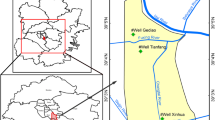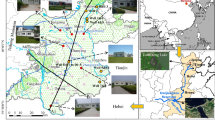Abstract
Land subsidence is the gradual or sudden dropping of the ground surface developed by increasing the total stress. Most studies have discussed the relationship between land subsidence with groundwater level. However, there is a lack of discussion on groundwater environmental changes after occurring land subsidence. This study aimed to evaluate the hydrogeological and water chemistry characteristics of construction sites with land subsidence. Land subsidence in the Yangyang coastal area occurred suddenly on August 3, 2022, when the retaining wall of the construction collapsed. The groundwater level was measured three times, and water samples were collected twice between August 5, 2022, and September 5, 2022, for laboratory analysis. After land subsidence occurred, the average groundwater level was − 19.91 m ground level (GL) on August 9, 2022, and finally decreased to − 19.21 m GL on September 05, 2022. The groundwater levels surrounding the construction site gradually increased for a month. The electrical conductivity value measured at the monitoring wells ranged from 89 to 7800 μS/cm, and four wells exceeded the measurement limit near the groundwater leaked points. The highest mixing ratio of leaked water samples, collected on August 9, 2022, was 27.6%. Furthermore, the fresh groundwater-saltwater interface depth was estimated to be above the construction bottom. Although groundwater levels recovered, the groundwater quality continuously is affected by saltwater. This finding could contribute to understanding the hydrogeological characteristics surrounding construction sites with land subsidence and provide insight into the hydrochemical evolution process during declined groundwater levels in coastal aquifers.









Similar content being viewed by others
Data availability
All data generated or analyzed during this study are included in this published article.
References
An, H., Ha, K., Lee, E., & Ko, K.-S. (2023). Analysis of groundwater quality variation characteristics using hydrogeochemical characteristics, ANOVA and trend analysis in rural areas. Journal of the Geological Society of Korea, 59(1), 69–89.
Andersen, P. F., Mercer, J. W., & White, H. O. (1988). Numerical modeling of salt-water intrusion at Hallandale. Florida. Groundwater, 26(5), 619–630.
Bagheri-Gavkosh, M., Hosseini, S. M., Ataie-Ashtiani, B., Sohani, Y., Ebrahimian, H., Morovat, F., & Ashrafi, S. (2021). Land subsidence: A global challenge. Science of the Total Environment, 778, 146193.
Banerjee, S., & Skidar, P. K. (2020). Land subsidence due to leakage of aquitard-aquifer pore water in an under-construction tunnel of East-West Metro Railway Project, Kolkata. Journal of the Geological Society of India, 96, 467–474.
Cardona, A., Carrillo-Rivera, J. J., Huizar-Álvarez, R., & Graniel-Castro, E. (2004). Salinization in coastal aquifers of arid zones: An example from Santo Domingo, Baja California Sur, Mexico. Environmental Geology, 45, 350–366.
CITYN (2020). Geotechnical investigation report: Underground safety impact assessment of living accommodation facility in Yangyang. CITYN, Sokcho, Korea, pp. 37–57. (in Korean).
Galloway, D. L., & Burbey, T. J. (2011). Review: Regional land subsidence accompanying groundwater extraction. Hydrogeology Journal, 19, 1459–1486.
Galloway, D. L., Jones, D. R., & Ingebritsen, S. E. (1999). Land subsidence in the United States. U.S. Geological Survey Circular, 1182, 7–13.
Galloway, D. L., Erkens, G., Kuniansky, E. L., & Rowland, J. C. (2016). Preface: Land subsidence processes. Hydrogeology Journal, 24, 547–550.
Gong, S. L., Li, C., & Yang, S. L. (2009). The microscopic characteristics of Shanghai soft clay and its effect on soil body deformation and land subsidence. Environmental Geology, 56(6), 1051–1056.
Guzy, A., & Malinowska, A. A. (2020). State of the art and recent advancements in the modelling of land subsidence induced by groundwater withdrawal. Water, 12, 2051.
Herrera-García, G., Ezquerro, P., Tomás, R., Béjar-Pizarro, M., López-Vinielles, J., Rossi, M., Mateos, R. M., Carreón-Freyre, D., Lambert, J., Teatini, P., Cabral-Cano, E., Erkens, G., Galloway, D., Hung, W. C., Kakar, K., Sneed, M., Tosi, L., Wang, H., & Ye, S. (2021). Mapping the global threat of land subsidence. Science, 371(6524), 34–36.
Jang, J., Lee, J.-Y., Oh, S., & Kim, Y.-I. (2022). Evaluation of hydrochemical characteristics and hydraulic connectivity using fluorescent mineral tracer test in karst region of Samcheock. Korea, Journal of the Geological Society of Korea, 58(3), 347–360.
Jeen, S.-W., Kang, J., Jung, H., & Lee, J. (2021). Review of seawater intrusion in western regions of South Korea. Water, 13(6), 761.
Jeon, W.-H., Lee, J.-Y., Cheong, W.-Y., Park, Y.-H., Oh, S.-H., Eum, D.-H., & Park, J.-Y. (2015). A multi-method approach revealing the groundwater-stream water interaction in the Inbuk stream, Korea. Geoscience Journal, 19, 325–340.
Jiao, J., & Post, V. (2019). Coastal hydrogeology. Cambridge University Press.
Liu, B., Liao, Y., Yan, S., & Yan, H. (2017). Dynamic characteristics of saltwater intrusion in the Pearl River Estuary, China. Natural Hazards, 89, 1097–1117.
Marfai, M. A., & King, L. (2007). Monitoring land subsidence in Semarang, Indonesia. Environmental Geology, 53, 651–659.
Michael, H. A., Post, V. E. A., Wilson, A. M., & Werner, A. D. (2017). Science, society and the coastal groundwater squeeze. Water Resources Research, 53, 2610–2617.
MoE & K-water (2021). Basic Survey Report of Groundwater in Yangyang, Ministry of Environment and K-water, Sejong, Korea. pp. 135–175. (in Korean).
Orhan, O. (2021). Monitoring of land subsidence due to excessive groundwater extraction using small baseline subset technique in Konya. Turkey. Environmental Monitoring and Assessment, 193, 174.
Park, C.-H., Huh, S., Jou, H.-T., Hong, J.-K., & Isezaki, N. (1997). Geological interpretation based on magnetic anomalies and seismic data offshore Yangyang-Samchuk, the East Sea of Korea. Journal of the Geological Society of Korea, 33(3), 117–126.
Phien-wej, N., Giao, P. H., & Nutalaya, P. (2006). Land subsidence in bangkok, Thailand. Engineering Geology, 82(4), 187–201.
Piper, A. M. (1944). A graphical procedure in the geochemical interpretation of water-analysis. EOS, Transactions American Geophysical Union, 25(6), 914–928.
Raza, M., & Lee, J.-Y. (2019). Factors affecting spatial pattern of groundwater hydrochemical variables and nitrate in agricultural region of Korea. Episodes, 42(2), 135–148.
Schoeller, H. (1956). Geochimie des eauxsouterraines application aux eaux de gisements de petrole. Revue De L’institut Français Du Pétrole Et Annales Des Combustibles Liquids, 10, 219–246.
Setiawan, I., Morgan, L. K., & Doscher, C. (2023). Saltwater intrusion from an estuarin river: A field investigation. Journal of Hydrology, 617, 128955.
Shen, J., Wu, Q., & Liu, W. (2020). The development of the water-richness evaluation model for the unconsolidated aquifers based on the extension matter-element theory. Geotechnical and Geological Engineering, 38, 2639–2652.
Shi, X., Jiang, S., Xu, H., Jiang, F., He, Z., & Wu, J. (2016). The effects of artificial recharge of groundwater on controlling land subsidence and its influence on groundwater quality and aquifer energy storage in Shanghai. China. Environmental Earth Science, 75, 195.
Shirzaei, M., Freymueller, J., Törnqvist, T. E., Galloway, D. L., Dura, T., & Minderhoud, P. S. (2021). Measuring, modelling and projecting coastal land subsidence. Nature Reviews Earth & Environment, 2(1), 40–58.
Song, K. -Y., Park, S. -I. & Jo, D. -L., (2011), Geological report of the Sokcho-Yangyang sheet (scale 1:50,000). Korea Institute of Geoscience and Mineral Resources (KIGAM), Daejeon, Korea, pp. 6–52. (in Korean with English summary).
Stuyfzand, P.J. (2008). Base-exchange indices as indicators of salinization or freshening of (coastal) aquifers. In Proceedings of 20th Salt Water Intrusion Meeting. Florida, June 23–27. pp. 262–265.
Terzaghi, K. (1925). Principles of soil mechanics, IV—Settlement and consolidation of clay. Engineering News-Record, 95(3) 874–878.
Todd, D. K. (1959). Groundwater Hydrology (1st ed.). Willey.
Wei, Z. X., Zhai, G. Y., & Yan, X. X. (2010). Atlas of Shanghai urban geology. Geology Press.
Wu, Y.-X., Lyu, H.-M., Shen, J.S., & Arulrajah, A. (2018). Geological and hydrogeological environment in Tianjin with potential geohazards and groundwater control during excavation. Environmental Earth Sciences, 77, 392.
Xu, Y. S., Shen, S. L., Cai, Z.-Y., & Zhou, G.-Y. (2008). The state of land subsidence and prediction approaches due to groundwater withdrawal in China. Natural Hazards, 45, 123–135.
Xu, Y.-S., Ma, L., Du, Y.-J., & Shen, S.-L. (2012). Analysis of urbanisation-induced land subsidence in Shanghai. Natural Hazards, 63, 1255–1267.
Xu, Y.-S., Shen, S.-L., Ma, L., Sun, W.-J., & Yin, Z.-Y. (2014). Evaluation of the blocking effect of retaining walls on groundwater seepage in aquifers with different insertion depths. Engineering Geology, 183, 254–264.
Xu, Y.-S., Wu, H.-N., Wang, B.Z.-F., & Yang, T.-L. (2017). Dewatering induced subsidence during excavation in a Shanghai soft deposit. Environmental Earth Science, 76, 351.
Yan, X., Xu, Y., Yang, T., Tosi, L., Stouthamer, E., Minderhoud, P., Teatini, P., Kooi, H., Andreas, H., Pradipta, D., Donnici, S., & Bonì, R. (2022). Sustainable development of coastal cities through control of land subsidence: Activities of IGCP Project 663 in Jakarta. Episodes, 45(1), 101–108.
Funding
This research was supported by the Basic Science Research Program through the National Research Foundation of Korea (NRF) funded by the Ministry of Education (No.2019R1A6A1A03033167).
Author information
Authors and Affiliations
Contributions
JJ: investigation, methodology, data curation, conceptualization, visualization, writing—original draft, writing—review and editing. J-YL: supervision, writing—review, editing, validation, funding acquisition, and project administration. MoR: writing—review and editing. MaR: writing—review. ML: investigation, writing—review, visualization, and editing. SO: data curation, visualization, conceptualization, and writing—review and editing.
Corresponding author
Ethics declarations
Ethics approval
All authors have read, understood, and complied as applicable with the statement on “Ethical responsibilities of Authors” as found in the Instructions for Authors.
Consent to participate
Not applicable.
Consent for publication
Not applicable.
Competing interests
The authors declare no competing interests.
Additional information
Publisher's note
Springer Nature remains neutral with regard to jurisdictional claims in published maps and institutional affiliations.
Rights and permissions
Springer Nature or its licensor (e.g. a society or other partner) holds exclusive rights to this article under a publishing agreement with the author(s) or other rightsholder(s); author self-archiving of the accepted manuscript version of this article is solely governed by the terms of such publishing agreement and applicable law.
About this article
Cite this article
Jang, J., Lee, JY., Redwan, M. et al. Hydrogeological characteristics and water chemistry in a coastal aquifer of Korea: implications for land subsidence. Environ Monit Assess 195, 1289 (2023). https://doi.org/10.1007/s10661-023-11926-y
Received:
Accepted:
Published:
DOI: https://doi.org/10.1007/s10661-023-11926-y




